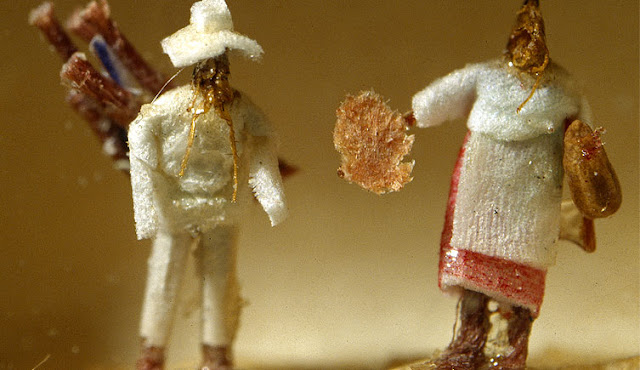At 06:30 Sundays BBC Radio 4 airs a programme called Natural Histories. I listen to it as I prepare breakfast. This is one of the many wonders of our public service broadcaster that would be lost if the mendacious plans of our current government to abolish the BBC come to pass. This Sunday 6 December the topic was the flea. The flea, it turns out, is the object of scientific study, but also a trope in erotic poetry since Roman times. An editor from the OED informed listeners that ‘flea’ occurs in many English idioms: we can be a fit as a flea; when in trouble we get a flea in our ear; we might watch a film in a fleapit (so called because fleas were endemic in early cinemas); we can shop for curios in a flea market. Fleas also made an appearance in music, at least once, in Herb Alpert and the Tijuana Brass’ song:
There was a little Spanish flea
A record star he thought he'd be
He heard of singers like Beatles
And The Chipmunks he'd seen on TV
Why not a little Spanish flea?
Fleas influenced fashion in Medieval Europe: a flea trap was an accessory consisting of a tube of a sticky substance that women wore round their necks. The evolved to be expensive items of gold jewelry filled with honey to tempt the flea to its death. Fleas also had a role in advertising and marketing: the flea circus originated as a means for jewellers to display their skill in working on a very small scale to make harnesses for performing fleas using very fine wire.
And, to my surprise, they had a place in the history of tourist art in Mexico. Octavio Paz, Mexico’s greatest poet wrote about fleas in his meditation about the essence of Mexicanness, El laberinto de la soledad (‘The Labyrinth of Solitude’):
Todas nuestras facultades, y también todos nuestros defectos, se oponen a esta concepción del trabajo como esfuerzo impersonal, repetido en iguales y vacias porciones de tiempo: la lentitud y cuidado en la tarea, el amor por la obra y por cada uno de los detalles que la componen, el buen gusto, innato ya, a fuerza de ser herencia milenaria. Si no fabricamos productos en serie, sobresalimos en el arte difícil, exquisito e inútil de vestir pulgas. Lo que no quiere decir que el mexicano sea incapaz de convertirse en lo que se llama un buen obrero. Todo es cuestión de tiempo. Y nada, excepto un cambio histórico cada vez más remoto e inpensable, impedirá que el mexicano deje de ser un problema, un ser enigmático, y se convierta en una abstracción más.
All our faculties, and also all our defects, are opposed to this notion of work as an impersonal effort, repeated in equal and empty slices of time: the slowness and care taken in the task, the love of the artefact and of every one of the details it is composed of, the good taste, now innate, by dint of being a millenarian inheritance. If we do not make mass-produced products, we excel in the difficult, exquisite and useless art of dressing fleas. This does not mean that the Mexican is incapable of becoming what is termed a good worker. It is all a question of time. And nothing, except an historical shift which is ever more remote and unthinkable, will prevent the Mexican from ceasing to be a problem, an enigmatic being, and becoming just another abstraction.”

Mexican dressed fleas made in 1905, Natural History Museum, London
The Rothschild family plays a significant role in humanity’s interest in the flea. One Miriam Rothschild solved the mystery of how the flea manages to jump so high and so fast. It evolved to lose its wings, an encumbrance that could get tangled in the fur of its host. At the joint which once articulated the wing sits a rubber-like substance that is compressed and released to bounce like a rubber ball. Walter Rothschild achieved his childhood dream of owning a museum when he opened Walter’s Zoological Museum in 1892 in Tring, Hertfordshire. His collection included dressed fleas made in Mexico in the early 20th century. They are now in the collections of the National History Museum in London. American friends can find dressed fleas in the Carnegie Museum of Natural History in Pittsburgh.

Dressed fleas from the Walter Rothschild collection
The curious art of dressing fleas is thought to have begun in the state of Guanajuato, possibly in convents. After a time, dressed fleas became popular tourist souvenirs, especially scenes of a bride and groom serenaded by a mariachi band. The art lasted until the 1930s.

Mexican dressed fleas in the collection of the Carnegie Museum of Natural History
Mexicans still make and sell tourist art on the country’s beaches, in its cities, on major archaeological sites, and in the shops of the Fondo Nacional para el Fomento de las Artesanías (National Foundation for the Promotion of Crafts). But they have now also proved Paz’s prediction to be correct: they work in high tech jobs in manufacturing, they run multinational businesses, their food and drink is consumed worldwide. Alas, they no longer dress fleas.

No comments:
Post a Comment